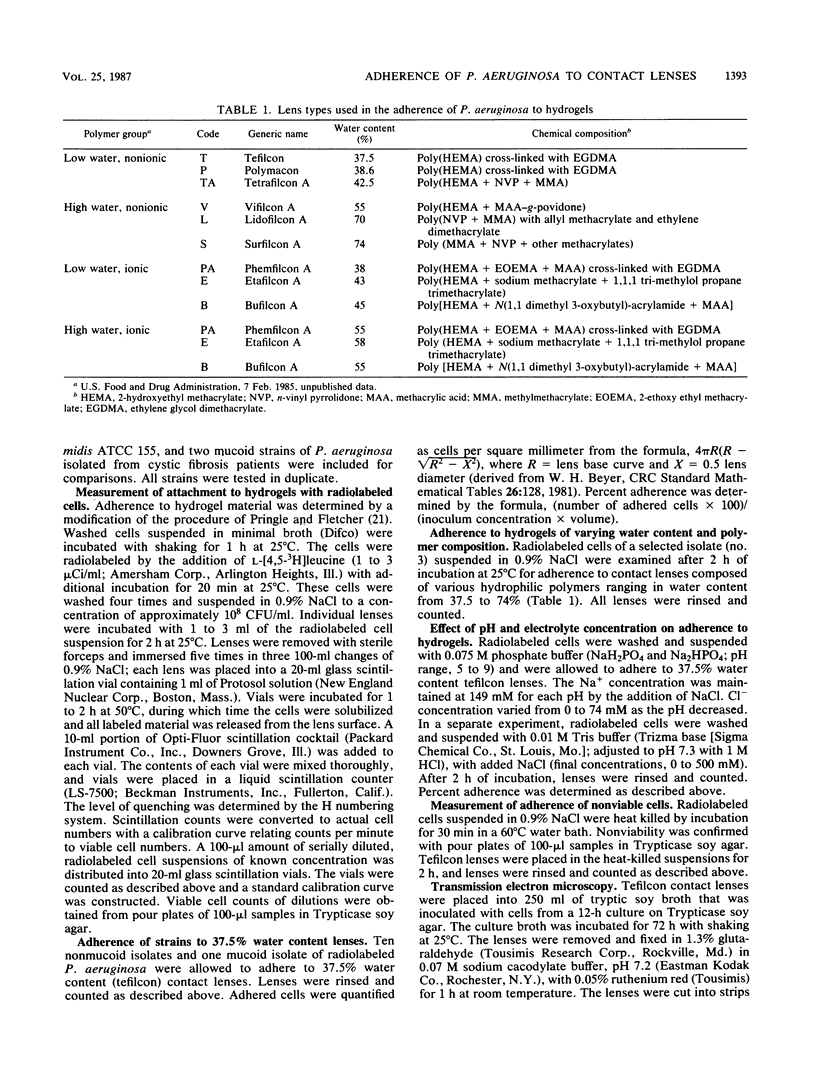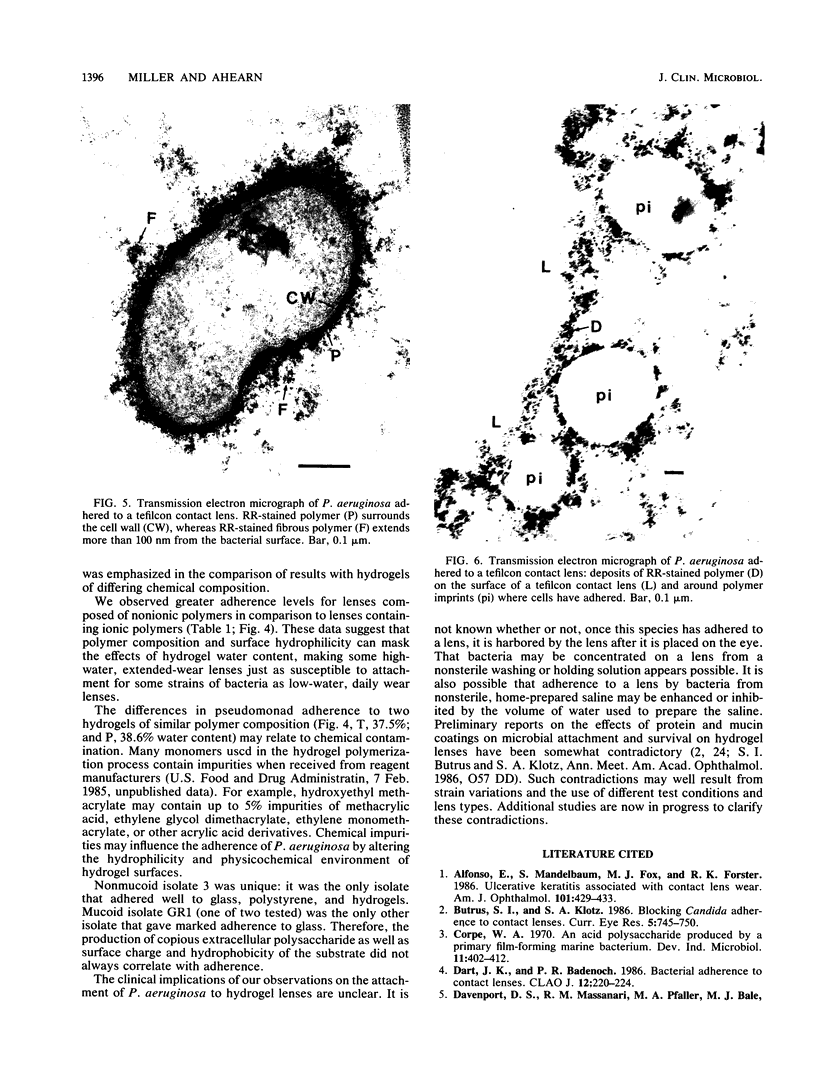Abstract
Nonmucoid Pseudomonas aeruginosa isolated from corneal ulcers and contact lens cases and solutions were examined for their ability to adhere to polystyrene, glass, and hydrophilic contact lenses of varying water content and polymer composition. Adherence to the various substrates was strain specific. Adherence also was influenced by hydrophobicity and chemical composition of the substratum, as well as pH and electrolyte concentration. An extracellular polymeric adhesive appeared to be involved in the firm attachment of cells to soft contact lenses.
Full text
PDF





Images in this article
Selected References
These references are in PubMed. This may not be the complete list of references from this article.
- Alfonso E., Mandelbaum S., Fox M. J., Forster R. K. Ulcerative keratitis associated with contact lens wear. Am J Ophthalmol. 1986 Apr 15;101(4):429–433. doi: 10.1016/0002-9394(86)90641-0. [DOI] [PubMed] [Google Scholar]
- Butrus S. I., Klotz S. A. Blocking Candida adherence to contact lenses. Curr Eye Res. 1986 Oct;5(10):745–750. doi: 10.3109/02713688609000015. [DOI] [PubMed] [Google Scholar]
- Dart J. K., Badenoch P. R. Bacterial adherence to contact lenses. CLAO J. 1986 Oct-Dec;12(4):220–224. [PubMed] [Google Scholar]
- Davenport D. S., Massanari R. M., Pfaller M. A., Bale M. J., Streed S. A., Hierholzer W. J., Jr Usefulness of a test for slime production as a marker for clinically significant infections with coagulase-negative staphylococci. J Infect Dis. 1986 Feb;153(2):332–339. doi: 10.1093/infdis/153.2.332. [DOI] [PubMed] [Google Scholar]
- Donnenfeld E. D., Cohen E. J., Arentsen J. J., Genvert G. I., Laibson P. R. Changing trends in contact lens associated corneal ulcers: an overview of 116 cases. CLAO J. 1986 Jul-Sep;12(3):145–149. [PubMed] [Google Scholar]
- Fletcher M., Loeb G. I. Influence of substratum characteristics on the attachment of a marine pseudomonad to solid surfaces. Appl Environ Microbiol. 1979 Jan;37(1):67–72. doi: 10.1128/aem.37.1.67-72.1979. [DOI] [PMC free article] [PubMed] [Google Scholar]
- Fletcher M., Marshall K. C. Bubble contact angle method for evaluating substratum interfacial characteristics and its relevance to bacterial attachment. Appl Environ Microbiol. 1982 Jul;44(1):184–192. doi: 10.1128/aem.44.1.184-192.1982. [DOI] [PMC free article] [PubMed] [Google Scholar]
- Galentine P. G., Cohen E. J., Laibson P. R., Adams C. P., Michaud R., Arentsen J. J. Corneal ulcers associated with contact lens wear. Arch Ophthalmol. 1984 Jun;102(6):891–894. doi: 10.1001/archopht.1984.01040030711025. [DOI] [PubMed] [Google Scholar]
- Marshall K. C., Cruickshank R. H. Cell surface hydrophobicity and the orientation of certain bacteria at interfaces. Arch Mikrobiol. 1973 Apr 8;91(1):29–40. doi: 10.1007/BF00409536. [DOI] [PubMed] [Google Scholar]
- Mayo M. S., Cook W. L., Schlitzer R. L., Ward M. A., Wilson L. A., Ahearn D. G. Antibiograms, serotypes, and plasmid profiles of Pseudomonas aeruginosa associated with corneal ulcers and contact lens wear. J Clin Microbiol. 1986 Sep;24(3):372–376. doi: 10.1128/jcm.24.3.372-376.1986. [DOI] [PMC free article] [PubMed] [Google Scholar]
- McEldowney S., Fletcher M. Variability of the influence of physicochemical factors affecting bacterial adhesion to polystyrene substrata. Appl Environ Microbiol. 1986 Sep;52(3):460–465. doi: 10.1128/aem.52.3.460-465.1986. [DOI] [PMC free article] [PubMed] [Google Scholar]
- Mondino B. J., Weissman B. A., Farb M. D., Pettit T. H. Corneal ulcers associated with daily-wear and extended-wear contact lenses. Am J Ophthalmol. 1986 Jul 15;102(1):58–65. doi: 10.1016/0002-9394(86)90210-2. [DOI] [PubMed] [Google Scholar]
- Ormerod L. D., Smith R. E. Contact lens-associated microbial keratitis. Arch Ophthalmol. 1986 Jan;104(1):79–83. doi: 10.1001/archopht.1986.01050130089027. [DOI] [PubMed] [Google Scholar]
- Patrinely J. R., Wilhelmus K. R., Rubin J. M., Key J. E., 2nd Bacterial keratitis associated with extended wear soft contact lenses. CLAO J. 1985 Jul-Sep;11(3):234–236. [PubMed] [Google Scholar]
- Pringle J. H., Fletcher M. Influence of substratum hydration and adsorbed macromolecules on bacterial attachment to surfaces. Appl Environ Microbiol. 1986 Jun;51(6):1321–1325. doi: 10.1128/aem.51.6.1321-1325.1986. [DOI] [PMC free article] [PubMed] [Google Scholar]
- Pringle J. H., Fletcher M. Influence of substratum wettability on attachment of freshwater bacteria to solid surfaces. Appl Environ Microbiol. 1983 Mar;45(3):811–817. doi: 10.1128/aem.45.3.811-817.1983. [DOI] [PMC free article] [PubMed] [Google Scholar]
- Rosenberg M. Bacterial adherence to polystyrene: a replica method of screening for bacterial hydrophobicity. Appl Environ Microbiol. 1981 Aug;42(2):375–377. doi: 10.1128/aem.42.2.375-377.1981. [DOI] [PMC free article] [PubMed] [Google Scholar]
- Stanley P. M. Factors affecting the irreversible attachment of Pseudomonas aeruginosa to stainless steel. Can J Microbiol. 1983 Nov;29(11):1493–1499. doi: 10.1139/m83-230. [DOI] [PubMed] [Google Scholar]
- Weissman B. A., Mondino B. J., Pettit T. H., Hofbauer J. D. Corneal ulcers associated with extended-wear soft contact lenses. Am J Ophthalmol. 1984 Apr;97(4):476–481. doi: 10.1016/s0002-9394(14)76131-8. [DOI] [PubMed] [Google Scholar]
- Wilson L. A., Schlitzer R. L., Ahearn D. G. Pseudomonas corneal ulcers associated with soft contact-lens wear. Am J Ophthalmol. 1981 Oct;92(4):546–554. doi: 10.1016/0002-9394(81)90649-8. [DOI] [PubMed] [Google Scholar]
- Zobell C. E. The Effect of Solid Surfaces upon Bacterial Activity. J Bacteriol. 1943 Jul;46(1):39–56. doi: 10.1128/jb.46.1.39-56.1943. [DOI] [PMC free article] [PubMed] [Google Scholar]




